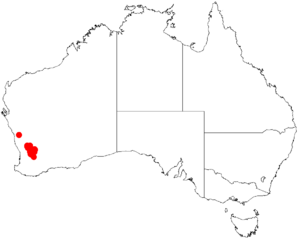Acacia phaeocalyx facts for kids
Quick facts for kids Acacia phaeocalyx |
|
|---|---|
| Conservation status | |
| Scientific classification | |
| Genus: |
Acacia
|
| Species: |
phaeocalyx
|
 |
|
| Occurrence data from AVH | |
Acacia phaeocalyx is a type of shrub, a small bushy plant, that belongs to the Acacia family. It is found only in the southwestern part of Australia. This means it is endemic to that area.
What it Looks Like
This shrub usually grows between 0.3 and 0.6 meters (about 1 to 2 feet) tall. It can grow in different ways, sometimes spreading out, sometimes growing in a compact shape. Its branches are smooth and often have a thin white powder on them.
- It has small, spiny parts called stipules, which are 2 to 4 millimeters long. These stipules curve slightly backwards.
- Like most Acacia plants, it doesn't have true leaves. Instead, it has special flattened stems called phyllodes that look and act like leaves.
- These phyllodes are green and feel tough. They are widest in the middle or slightly below it.
- Each phyllode is 8 to 15 millimeters long and 6 to 11 millimeters wide. They have a main vein running along one side.
The plant blooms, or flowers, from April to June. It produces bright yellow flowers.
- The flowers grow in simple, round clusters. Each cluster has seven to eight flowers that are not packed too tightly together.
- After the flowers, reddish-brown seed pods grow. These pods are tough and have slight curves and lines running along them.
- The pods are usually about 7 centimeters long and 4 millimeters wide.
- Inside the pods are dark brown seeds. These seeds are oblong (a bit like an oval) and are 4 to 5 millimeters long. They have a small, cone-shaped tip called an aril.
How it Got its Name
The plant was first officially described by a botanist named Bruce Maslin in 1978. He wrote about it in a science journal called Nuytsia.
Later, in 2003, another botanist named Leslie Pedley changed its name to Racosperma phaeocalyx. But then, in 2006, it was changed back to its original name, Acacia phaeocalyx.
Where it Grows
Acacia phaeocalyx is found in the central Wheatbelt region of Western Australia. It likes to grow on flat areas and hillsides. You'll often find it in sandy soils, especially where there's a type of soil called laterite.
Most of these plants grow between two towns: Wongan Hills in the northwest and Kellerberrin in the southeast. It usually grows as part of scrubland or tall shrubland areas.


